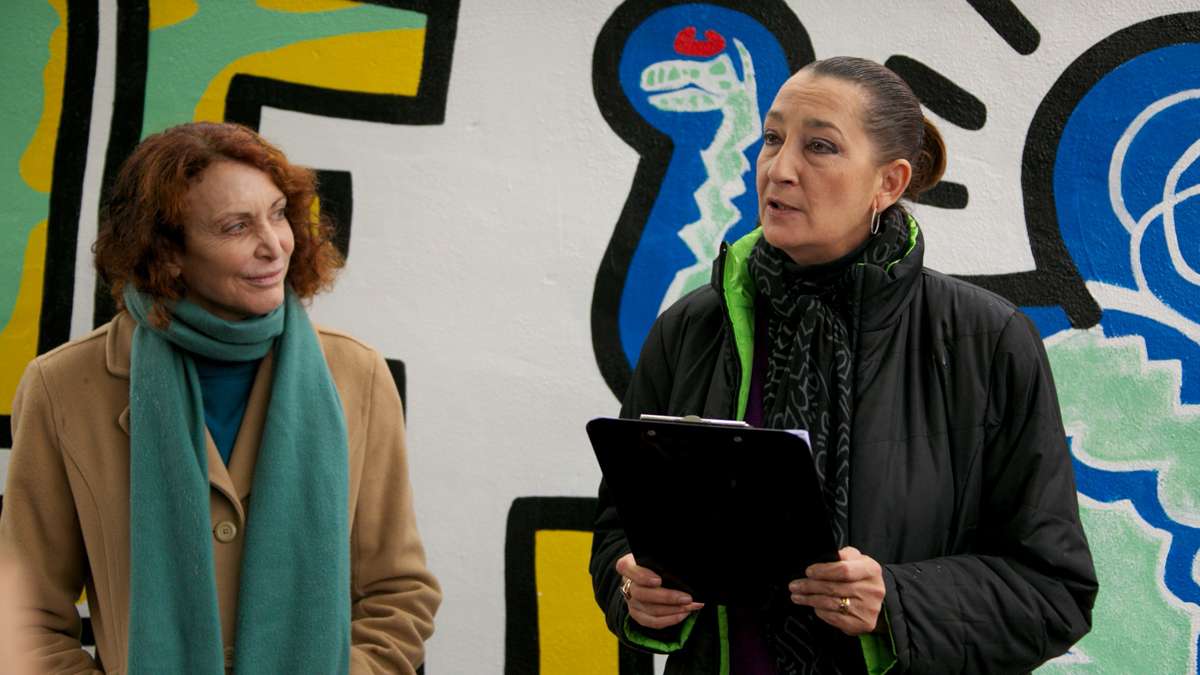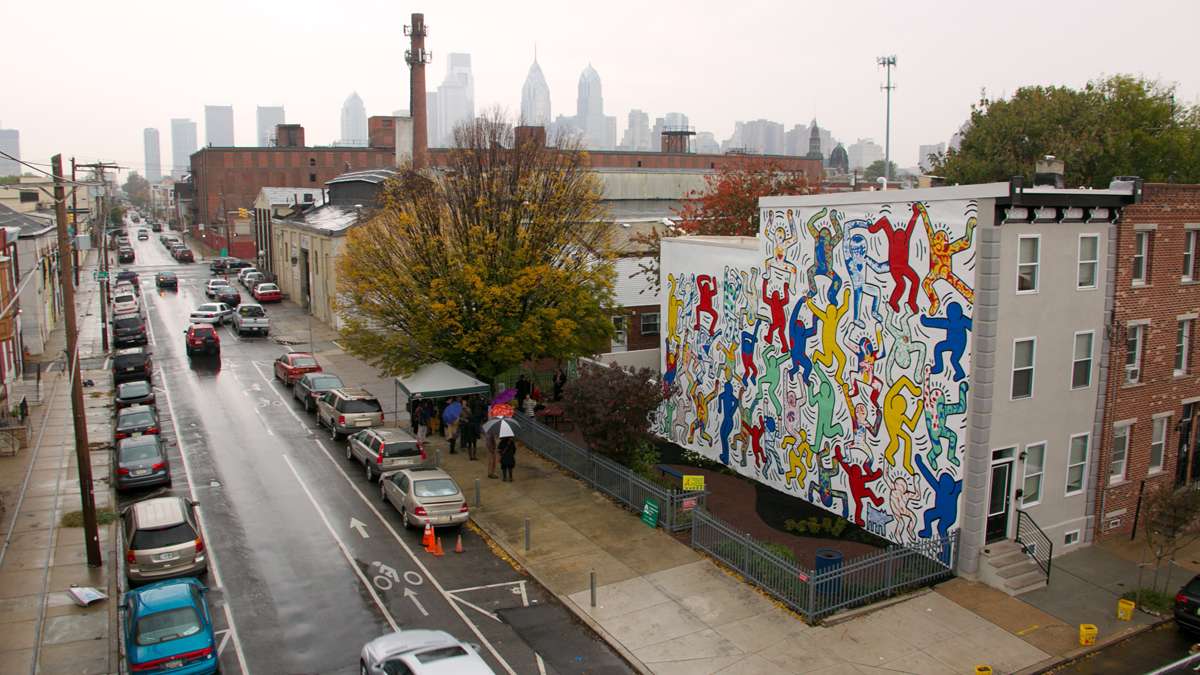Neither Christie nor Buono have a plan to fully fund New Jersey’s schools
-

Erica Bryant is the current homeowner of which the mural is painted on. (Nathaniel Hamilton/For NewsWorks)
-

“We the Youth” was originally created in 1987 and is the only intact Keith Haring mural in its original location. (Nathaniel Hamilton/For NewsWorks)
-

Jane Golden, Executive Director of The City of Philadelphia Mural Arts Program, celebrates the reopening with Julie Gruen, Executive Director of The Keith Haring Foundation. (Nathaniel Hamilton/For NewsWorks)
-

The Mural Arts Program restored a mural by iconic pop artist Keith Haring on the corner of 22nd and Ellsworth Streets. (Nathaniel Hamilton/For NewsWorks)
The latest poll has Republican Gov. Chris Christie ahead of Democratic state Senator Barbara Buono by 33 points in next week’s gubernatorial event. (“Race” seems too contentious a word.) Nonetheless, television and radio advertisements blare, partisan tweeters screech, PACS crank out dough, and both campaigns emit endless endorsements and rationales for their respective candidates. Hey, you never know. Upsets happen.
There’s much at stake, depending on your political proclivities. If the platforms of Christie and Buono were depicted by a Venn diagram, there would be little overlap between the two circles. This lack of common ground is obvious in many ways — social issues, for example, like marriage equality and abortion rights — but it’s a gaping expanse in the zone of public education. On hot-button issues like charter school expansion, vouchers, universal pre-school, high-stakes testing, even the general effectiveness of our current 591-district infrastructure, the two candidates diverge dramatically.
But one hard fact confounds campaign rhetoric. New Jersey spends a lot of money on public education – more than $8 billion a year, a quarter of our annual $33 billion budget — and this degree of largesse is unsustainable. While neither candidate acknowledges the need for systemic structural reform, it might do everyone some good to look squarely and strategically at the numbers.
Gov. Christie’s team likes to characterize the Governor as a fiscal whiz, but a front page article in Wednesday’s New York Times had little good to say about Christie’s budget management style:
“Wall Street ratings agencies and nonpartisan commissions… have been sounding warnings about Mr. Christie’s financial management since early in his tenure. The governor has promoted a ‘Jersey Comeback,’ but an analysis of budgets across the country in June rated New Jersey and Georgia as highest in “fiscal stress”…Spending continues to expand. Mr. Christie’s budget for 2014, at just shy of $33 billion, will reach the second-highest amount in state history and more than Governor Corzine’s did in his last two years in office. “
Now, let’s be fair. While Christie has trod the well-worn path of his predecessors in relying on one-shot gimmicks to close budget holes, his hands are pretty well tied on management of our public education spreadsheet. Over thirty years ago the State Supreme Court issued the first of 21 Abbott decisions, ordering the State to halt the regressive practice of having school districts raise their own funding through local property taxes. Instead, deemed the jurists, the State must compensate poor (so-called Abbott) districts in order to achieve some degree of educational equity.
Two decades later came state Sen. Buono’s greatest role: as head of the Senate Budget Committee, she was the primary sponsor of the Corzine Administration’s School Funding Reform Act of 2008 (SFRA), which proposes to funnel school aid directly to poor students regardless of district of residence. In theory SFRA makes a lot of sense: poor children live all over the State, not just in 31 designated Abbott districts, and the new funding formula precludes new lawsuits on behalf of non-Abbott children who lacked adequate resources.
Enter reality, stage right. The State couldn’t pay the education tab, advocates for poor children (Education Law Center) went back to Court, and we reverted to Abbott funding until the State could fully fund SFRA.
Fully funding SFRA would cost another $1 billion per year. We don’t have the money.
Gov. Christie has been largely silent on any new strategies for satisfying the Court, besides touting exorbitant per pupil costs in Abbott districts ($27K per student per year, for instance, in Asbury Park) and pressing for other marginal ideas like private and parochial school vouchers. Many expect him to stack the odds in his favor by appointing friendly justices who might overturn Abbott.
Sen. Buono, however, has trumpeted her own unrealistic strategy: spend more, particularly on universal preschool and full-day kindergartens, even though she knows that increased funding is a pipedream: just this week at a campaign stop in Nutley, she conceded that expansion of preschools could take a decade or more, telling supporters, “[w]e didn’t have the resources back then and we certainly don’t have them now.”
Our problem is beyond any quick fix. New Jersey is like a fractal, an endless loop of repeating patterns: 565 municipalities, 591 school districts and school boards, redundant police and fire departments and town councils, echoing across the state like an eternal set of those nesting Matryoska dolls. We love the charm of municipal madness, but not the price tag, and it’s a profligate way to run a state, let alone a state school system. Until we find the stomach and sanity for meaningful structural reform, we’ll be stuck with rhetoric, gimmicks, and campaign sound bites.
________________________________________________
Laura Waters is president of the Lawrence Township School Board in Mercer County. She also writes about New Jersey’s public education on her blog NJ Left Behind. Follow her on Twitter @NJLeftbehind.
WHYY is your source for fact-based, in-depth journalism and information. As a nonprofit organization, we rely on financial support from readers like you. Please give today.





